
OUIDAH, BENIN, 25 OCTOBER 2019: Assiba Atonhou is only 24 years old. She has a four year-old son named Jeremy. Assiba contracted leprosy when she was 12 years old and it has ravaged her young body. She first discovered a wound on her arm that she said burnt her. Her parents took her to a traditional healer and he wasted their time and money for a few crucial years while the disease took over her body. Assiba says she was close to death when her parents were visited by one of a sisters of the local leprosy center. The sisters discovered her there and nursed her back to life. Assiba received treatment there for 3 years and then went home again. She became pregnant around that time. After she gave birth, she says the wounds reappeared and she became sick again. Assiba has lost faith in the treatment which she says does not work for her. Her biggest concern is Jeremy and how to pay for his schooling. Jeremy’s father is not involved at all and has abandoned his child. Assiba is totally reliant on the center for support and even though she says she is very bored of being there, she must remain as she has no other means of support. She prays often that she can be cured and leave the center for a normal life. (Photo by Brent Stirton/Getty Images)

OUIDAH, BENIN, 25 OCTOBER 2019: Assiba Atonhou is only 24 years old. She has a four year-old son named Jeremy. Assiba contracted leprosy when she was 12 years old and it has ravaged her young body. She first discovered a wound on her arm that she said burnt her. Her parents took her to a traditional healer and he wasted their time and money for a few crucial years while the disease took over her body. Assiba says she was close to death when her parents were visited by one of a sisters of the local leprosy center. The sisters discovered her there and nursed her back to life. Assiba received treatment there for 3 years and then went home again. She became pregnant around that time. After she gave birth, she says the wounds reappeared and she became sick again. Assiba has lost faith in the treatment which she says does not work for her. Her biggest concern is Jeremy and how to pay for his schooling. Jeremy’s father is not involved at all and has abandoned his child. Assiba is totally reliant on the center for support and even though she says she is very bored of being there, she must remain as she has no other means of support. She prays often that she can be cured and leave the center for a normal life. (Photo by Brent Stirton/Getty Images)

OUIDAH, BENIN, 25 OCTOBER 2019: Assiba Atonhou is only 24 years old. She has a four year-old son named Jeremy. Assiba contracted leprosy when she was 12 years old and it has ravaged her young body. She first discovered a wound on her arm that she said burnt her. Her parents took her to a traditional healer and he wasted their time and money for a few crucial years while the disease took over her body. Assiba says she was close to death when her parents were visited by one of a sisters of the local leprosy center. The sisters discovered her there and nursed her back to life. Assiba received treatment there for 3 years and then went home again. She became pregnant around that time. After she gave birth, she says the wounds reappeared and she became sick again. Assiba has lost faith in the treatment which she says does not work for her. Her biggest concern is Jeremy and how to pay for his schooling. Jeremy’s father is not involved at all and has abandoned his child. Assiba is totally reliant on the center for support and even though she says she is very bored of being there, she must remain as she has no other means of support. She prays often that she can be cured and leave the center for a normal life. (Photo by Brent Stirton/Getty Images)

MADJRE, DOGBO, BENIN: Patients at the Anti-Leprosy center in Madire, Benin. The patients at this center are here because they have been ostracized from their families and communities and have no-one to care fro them. There are currently 32 patients at the center and there are 9 centers across Benin. :eprosy remains a global disease, despite many people thinking it was eradicated centuries ago. Leprosy is a chronic bacterial disease that primarily affects the skin, peripheral nerves and upper airway. Feared as a highly contagious and devastating disease, it is well established that Hansen's disease (leprosy) is not highly transmissible, is very treatable, and, with early diagnosis and treatment, is not disabling. Leprosy remains a misunderstood human infectious disease. The stigma long associated with the disease still exists in most of the world and the psychological and social effects may be more difficult to deal with than the actual physical illness. (photo by Brent Stirton/Getty Images.)

MADJRE, DOGBO, BENIN, OCTOBER 22, 2019: Sister Alphonsine Hounkpe, 45, became a nun in 2003. She says it was always her calling, she remembers feeling this as young as 6 years old. She did not have access to education until later, starting school at 11. She then became a nurse before committing her life to the church in 2003. In 2015 she was asked to go to the Leprosy center in Madjre where she has been dispensing care ever since. Long term residents say she offers great care and love, more so than anyone else they can remember. They also say she has a great sense of humor and is funny and uplifting to be around. “This is my calling, she says, I am obliged to give them hope and joy.” (Photo by Brent Stirton/Getty Images.)

MADJRE, DOGBO, BENIN, OCTOBER 22, 2019: Gilbert Abalo, 55, is a child victim of Leprosy, he has suffered from the symptoms for over 40 years. He has lived at the Madjre Anti-Leprosy center for over 25 years. He lost his leg to gangrene over 6 years ago. Throughout it all, Gilbert has maintained an incredible sense of humor, “I laugh all the time, this disease is not a curse from someone else, like some people think. It is just something I live with now. It is in the hands of God.” Gilbert was unable to marry despite a woman he knew wanting that. Her parent prevented the union. Now he lives quietly at the center, raising chickens, maintaining a perfectly clean house and bringing humor wherever he goes. (Photo by Brent Stirton/Getty Images.)

MADJRE, DOGBO, BENIN, OCTOBER 22, 2019: Gilbert Abalo, 55, is a child victim of Leprosy, he has suffered from the symptoms for over 40 years. He has lived at the Madjre Anti-Leprosy center for over 25 years. He lost his leg to gangrene over 6 years ago. Throughout it all, Gilbert has maintained an incredible sense of humor, “I laugh all the time, this disease is not a curse from someone else, like some people think. It is just something I live with now. It is in the hands of God.” Gilbert was unable to marry despite a woman he knew wanting that. Her parent prevented the union. Now he lives quietly at the center, raising chickens, maintaining a perfectly clean house and bringing humor wherever he goes. (Photo by Brent Stirton/Getty Images.)

Agnove Island, Benin: This island is a place where Lepers were once isolated, living lives cut off from society. Today, it is a fishing village and there are only three people on the island with Leprosy. This is because the local hospital is aware of the disease and medical personel who work in this area know what to look for. Dadjro Adoubekenon, 74, is from a family where three people had leprosy. He has it now but is on treatment and remains hopeful about returning to work as a fisherman once his treatment is complete. He has 6 kids and his primary concern is how to support his family. Prior to going on treatment for the disease, Dadjro did not leave his house for 4 months and his family were preparing for his death. Leprosy is a chronic bacterial disease that primarily affects the skin, peripheral nerves and upper airway. Feared as a highly contagious and devastating disease, it is well established that Hansen's disease (leprosy) is not highly transmissible, is very treatable, and, with early diagnosis and treatment, is not disabling. Leprosy remains a misunderstood human infectious disease. The stigma long associated with the disease still exists in most of the world and the psychological and social effects may be more difficult to deal with than the actual physical illness. (photo by Brent Stirton/Getty Images.)

Agnove Island, Benin: This island is a place where Lepers were once isolated, living lives cut off from society. Today, it is a fishing village and there are only three people on the island with Leprosy. This is because the local hospital is aware of the disease and medical personel who work in this area know what to look for. Dadjro Adoubekenon, 74, is from a family where three people had leprosy. He has it now but is on treatment and remains hopeful about returning to work as a fisherman once his treatment is complete. He has 6 kids and his primary concern is how to support his family. Prior to going on treatment for the disease, Dadjro did not leave his house for 4 months and his family were preparing for his death. Leprosy is a chronic bacterial disease that primarily affects the skin, peripheral nerves and upper airway. Feared as a highly contagious and devastating disease, it is well established that Hansen's disease (leprosy) is not highly transmissible, is very treatable, and, with early diagnosis and treatment, is not disabling. Leprosy remains a misunderstood human infectious disease. The stigma long associated with the disease still exists in most of the world and the psychological and social effects may be more difficult to deal with than the actual physical illness. (photo by Brent Stirton/Getty Images.)

Dogbo, Benin: Ouinsson Hounssi, 12, is a recent survivor of Leprosy. She contracted the disease from her mother, who did not know she had the disease.. They were both treated at the same time, on an anti-biotic regime for a year. The bacteria that causes the disease is insidious and first attacks the nerve endings. typically in the feet and the hands. People who contract the disease usually find out too late to prevent nerve damage that is permanent. That is what happened to Ouinsson’s hands, they are permanently damaged from the disease, despite it being eradicated from her body. One of the key goals with those who fight against the spread of Leprosy is to get to children as early as possible to end deformity. There are currently 9 Leprosy centers in Benin and the disease is still present in many countries around the world. Leprosy is a chronic bacterial disease that primarily affects the skin, peripheral nerves and upper airway. Feared as a highly contagious and devastating disease, it is well established that Hansen's disease (leprosy) is not highly transmissible, is very treatable, and, with early diagnosis and treatment, is not disabling. Leprosy remains a misunderstood human infectious disease. The stigma long associated with the disease still exists in most of the world and the psychological and social effects may be more difficult to deal with than the actual physical illness. (photo by Brent Stirton/Getty Images.)

MADJRE, DOGBO, BENIN, OCTOBER 22, 2019: Beatrice Hounkpevi, 49, was 16 when she was first diagnosed with Leprosy. She lost her toes within the first two years. In 2018 she finally lost her leg to gangrene. She is seen having a talk and a laugh with Sister Alphonsine who takes care of the lepers with two other sisters. They have an excellent relationship and Beatrice says Sister Alphonsine helps her in life every day. Beatrice was born in Togo and explains that when she went to school there, they had to cross a river twice a day to get there. She believes that is where she contracted Leprosy. Beatrice has had two husbands, both of whom left her because of the disease. She had 5 children with her second husband, when he left her he decided to ban her children from seeing her, the great tragedy in her life. “From time to time, I will receive a phone call from one of them, that is the thing I live for. A call is enough and so I pray for that call.” (Photo by Brent Stirton/Getty Images.)

MADJRE, DOGBO, BENIN, OCTOBER 22, 2019: Sister Alphonsine Hounkpe, 45, is seen cleaning the wounds of lepers at the anti-leprosy center in Madjre. She became a nun in 2003. She says it was always her calling, she remembers feeling this as young as 6 years old. She did not have access to education until later, starting school at 11. She then became a nurse before committing her life to the church in 2003. In 2015 she was asked to go to the Anti Leprosy center in Madjre where she has been dispensing care ever since. Long term residents say she offers great care and love, more so than anyone else they can remember. They also say she has a great sense of humor and is funny and uplifting to be around. “This is my calling, she says, I am obliged to give them hope and joy.” (Photo by Brent Stirton/Getty Images.)

MADJRE, DOGBO, BENIN, OCTOBER 22, 2019: Mother and Son, Angele Assi, 54 and her son Cyprien Tohou Egnon, 25. They have lived at the Madjre Anti-Leprosy center since 2017. In addition to Leprosy, Cyprien has some mental issues linked to the disease. Angele say of Cypriene, “He is my son, I will always be with him.” When Angele first displayed symptons, she went to a series of traditional healers who wasted valuable time and money in their misdiagnosis. This has been a common theme for many of these victims. Leprosy can be treated but it is vital it is diagnosed early and anti-biotics administered. Poverty, remote location, superstition, ignorance and a lack of qualified medical personnel all contribute to the endurance of this disease. (Photo by Brent Stirton/Getty Images.)

MADJRE, DOGBO, BENIN, OCTOBER 22, 2019: Veronica Gbado, 85, has had leprosy since the ago of 20. As a young woman, she lived in an area without access to western medicine and traditional healers wasted her time and money, resulting in a permanent condition. Veronica has lived in the Madjre Anti-Leprosy center for 21 years. She had five children in her life, 4 of whom died. She blames the tragedies of her life on witchcraft. (Photo by Brent Stirton/Getty Images.)

Ouidah, Benin: Robert Hounkankin, 8, developed a Burilli ulcer two months ago and it has already done serious damage to his arm. Buruli ulcer, caused by Mycobacterium ulcerans, is a chronic, debilitating, necrotizing disease of the skin and soft tissue. Buruli ulcer is an emerging infectious disease and is the third most common mycobacterial disease of the immunocompetent host, after tuberculosis and leprosy. Although it has been reported in over 33 countries around the world, the greatest burden of disease is in the tropical regions of West and Central Africa, Australia, and Japan. It primarily affects children aged 5-15 years. Buruli ulcers generally begin as a painless dermal papule or subcutaneous edematous nodule, which, over a period of weeks to months, breaks down to form an extensive necrotic ulcer with undermined edges. Treatment includes a prolonged course of antibiotics and surgical debridement. Early identification and treatment are key, as lesions heal with scarring that can be a significant source of morbidity. (Photo by Brent Stirton/Getty Images.)

Ouidah, Benin: Joie Nontcho, 9, has been in hospital for the last two years due to debilitating and chronic Buruli ulcers which have been very difficult to get rid of. His sister dropped out of school and is with him to ensure he is cared for. Buruli ulcer, caused by Mycobacterium ulcerans, is a chronic, debilitating, necrotizing disease of the skin and soft tissue. Buruli ulcer is an emerging infectious disease and is the third most common mycobacterial disease of the immunocompetent host, after tuberculosis and leprosy. Although it has been reported in over 33 countries around the world, the greatest burden of disease is in the tropical regions of West and Central Africa, Australia, and Japan. It primarily affects children aged 5-15 years. Buruli ulcers generally begin as a painless dermal papule or subcutaneous edematous nodule, which, over a period of weeks to months, breaks down to form an extensive necrotic ulcer with undermined edges. Treatment includes a prolonged course of antibiotics and surgical debridement. Early identification and treatment are key, as lesions heal with scarring that can be a significant source of morbidity. (Photo by Brent Stirton/Getty Images.)

Gedefaye Metikie has had minor trichiasis (TT) for 3 or 4 years but has put off her surgery until her youngestchild is weaned. In the meantime, her oldest daughter Yalemworke Gashaw lovingly epilates the eyelashesrubbing against her mother’s eye between her fingernails in North Mecha Woreda, Amhara Region, Ethiopia.Gedefaye is aware that a simple 10–15 minute surgery is available free of charge through the Lions/CarterCenter Sightfirst Initiative offered by the Amhara Regional Health Bureau. Trachoma is an eye infection caused by the bacterium Chlamydia trachomatis. The bacterium is spreadby direct person-to-person contact, shared cloths and towels, and by eye-seeking flies. Children ages1–9 years and women harbor the greatest burden of disease. Repeated infections scar the inner eyelid,eventually causing the eyelid to turn inward. Once the eyelid has inverted, the eyelashes scratch thecornea, leading to irreversible blindness. Photo Credit: Brent Stirton/GettyImages

Esmael Habtamu from The Carter Center for Trachoma Control Program is seen checking an elderly lady for signs oftrachoma in North Mecha Woreda, Amhara region of Ethiopia. The Amhara region is the most endemic area inthe most endemic country. Trachoma is an eye infection caused by the bacterium Chlamydia trachomatis. The bacterium is spreadby direct person-to-person contact, shared cloths and towels, and by eye-seeking flies. Children ages1–9 years and women harbor the greatest burden of disease. Repeated infections scar the inner eyelid,eventually causing the eyelid to turn inward. Once the eyelid has inverted, the eyelashes scratch the cornea, leading to irreversible blindness. (Photo credit: Brent Stirton/Getty Images)

North Mecha Woreda, Amhara region of Ethiopia. A group of five woman all from the same family, all suffering from Trachoma induced blindness. They are waiting to have their eye covering removed after a remote clinic from the Carter foundation reached their area and identified them as candidates for surgery. The Amhara region is the most endemic area in the most endemic country. for Trachoma. Trachoma is an eye infection caused by the bacterium Chlamydia trachomatis. The bacterium is spreadby direct person-to-person contact, shared cloths and towels, and by eye-seeking flies. Children ages1–9 years and women harbor the greatest burden of disease. Repeated infections scar the inner eyelid,eventually causing the eyelid to turn inward. Once the eyelid has inverted, the eyelashes scratch the cornea, leading to irreversible blindness. Photo by Brent Stirton/Getty Images

North Mecha Woreda, Amhara region of Ethiopia. A local woman suffering from Trachoma induced blindness. She is waiting to see if her her eyes can be operated on by a remote clinic from the Carter foundation that reached their area and identified them as potential candidates for surgery. The Amhara region is the most endemic area in the most endemic country. for Trachoma. Trachoma is an eye infection caused by the bacterium Chlamydia trachomatis. The bacterium is spreadby direct person-to-person contact, shared cloths and towels, and by eye-seeking flies. Children ages1–9 years and women harbor the greatest burden of disease. Repeated infections scar the inner eyelid, eventually causing the eyelid to turn inward. Once the eyelid has inverted, the eyelashes scratch the cornea, leading to irreversible blindness. Photo by Brent Stirton/Getty Images
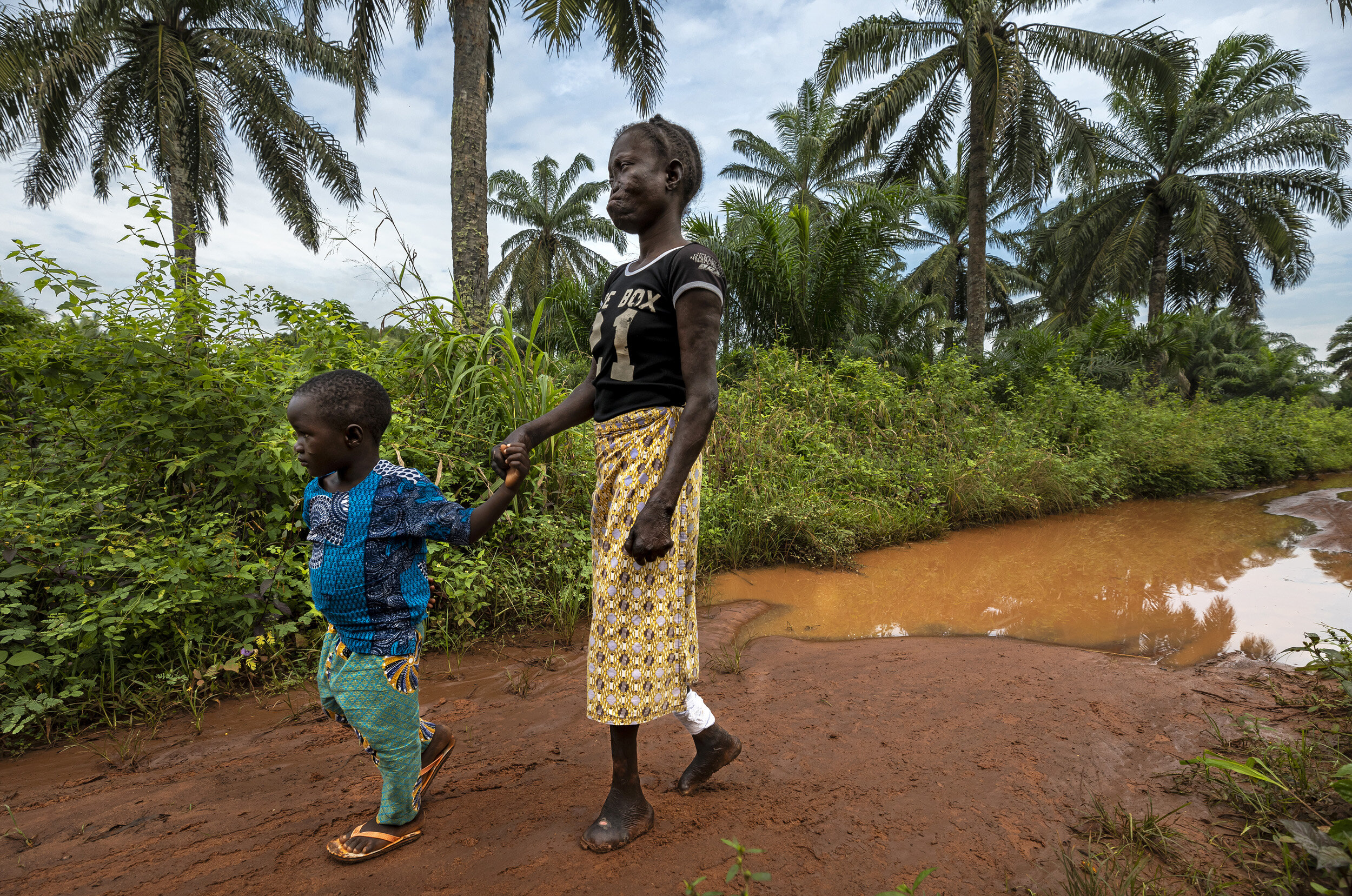
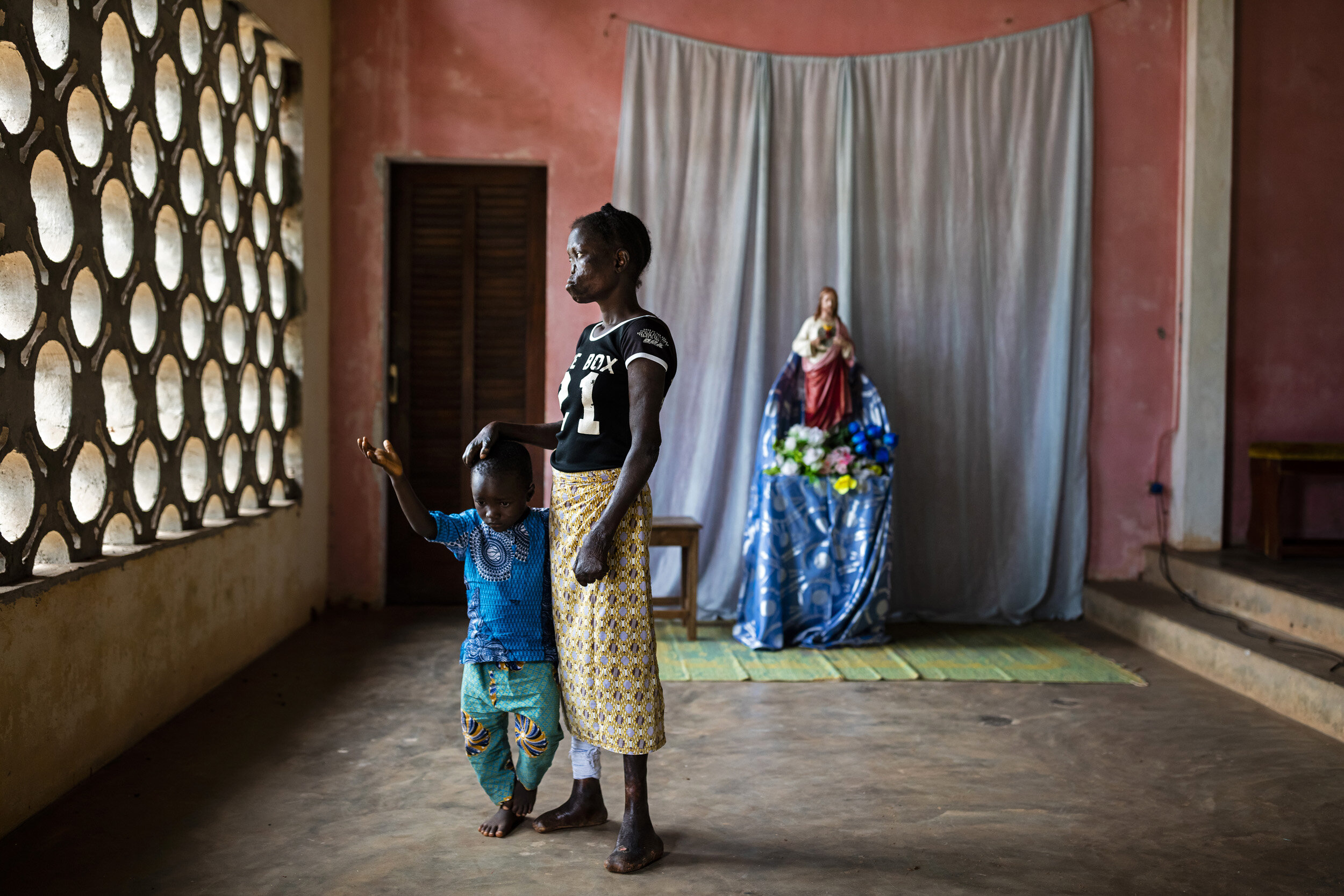
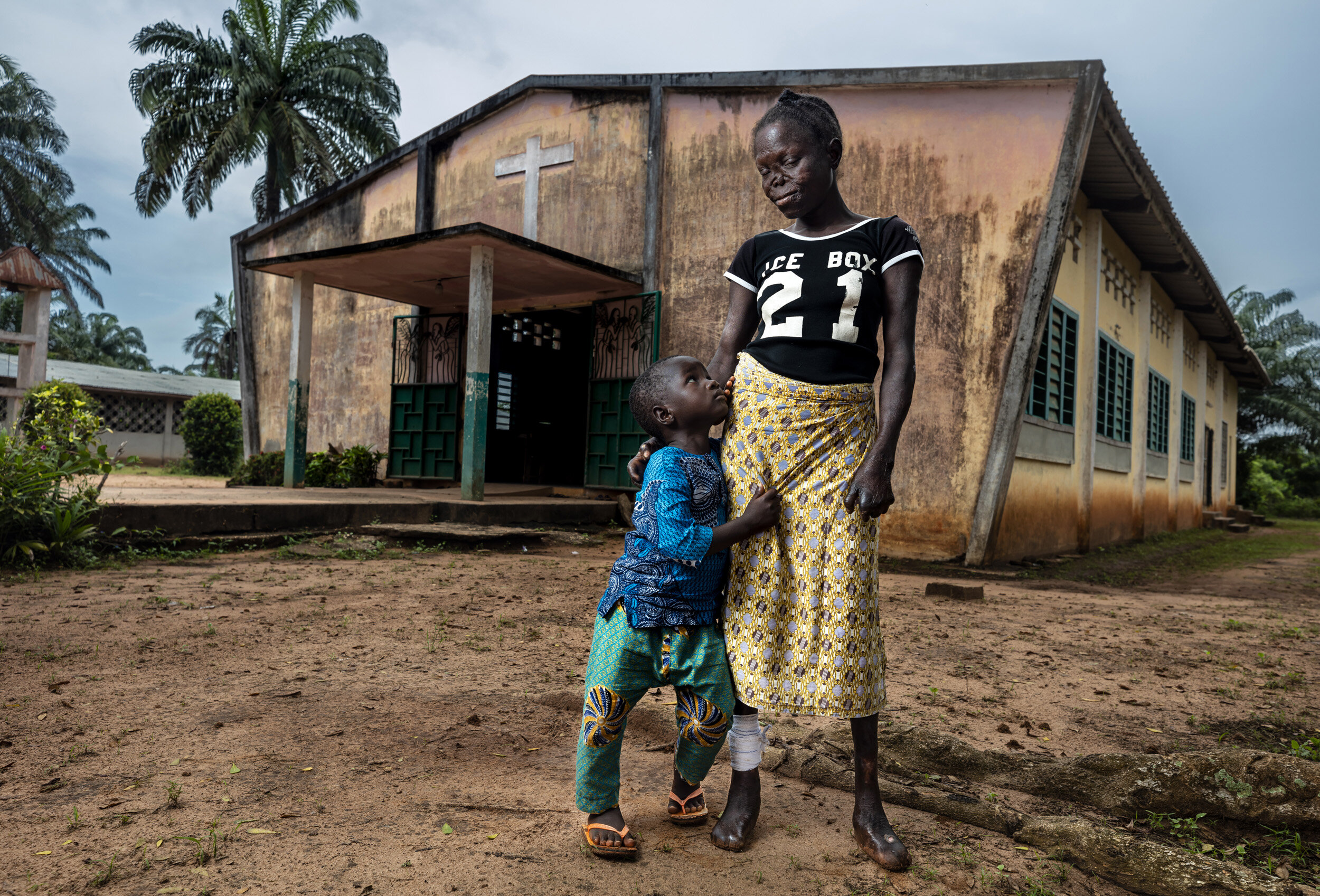
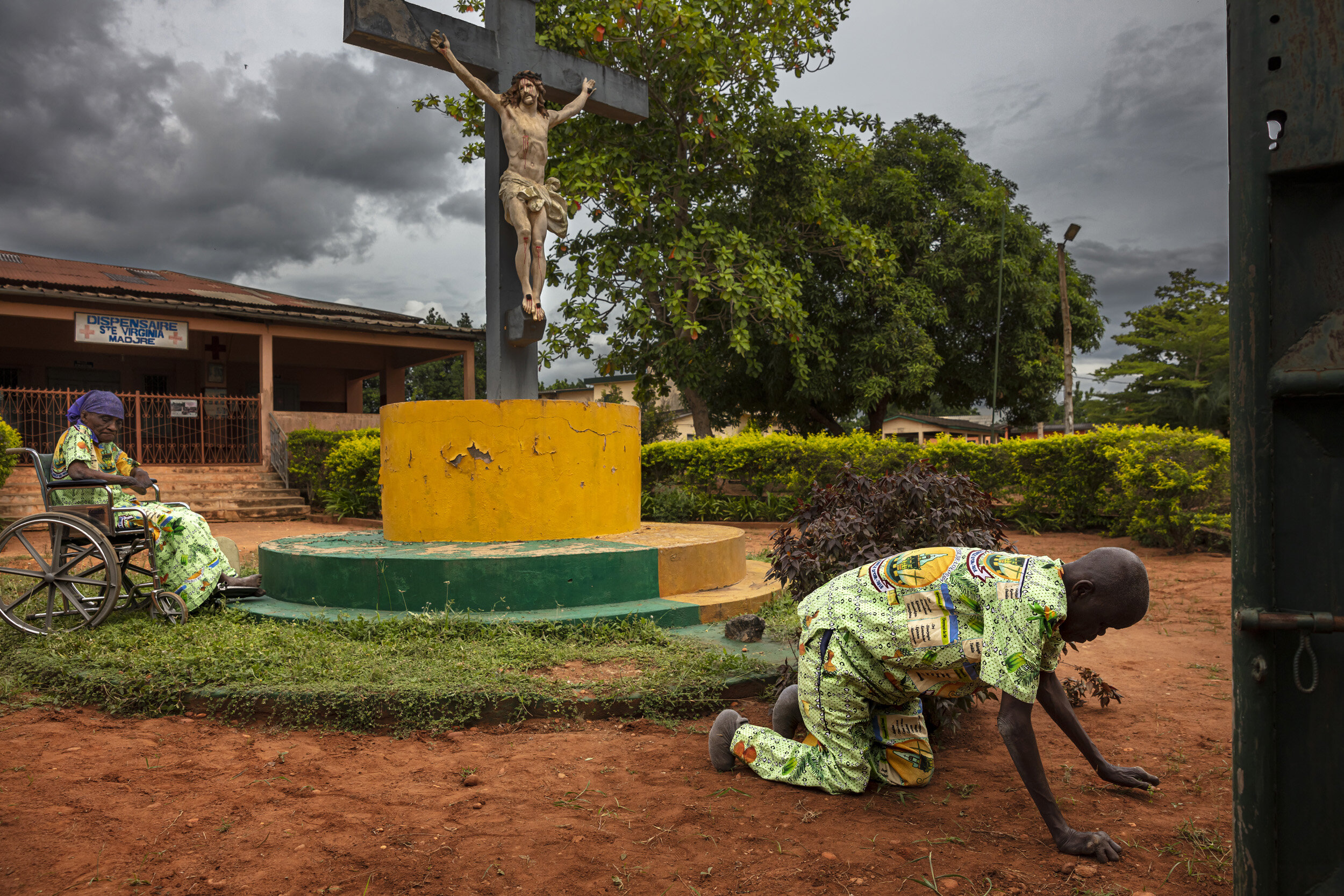

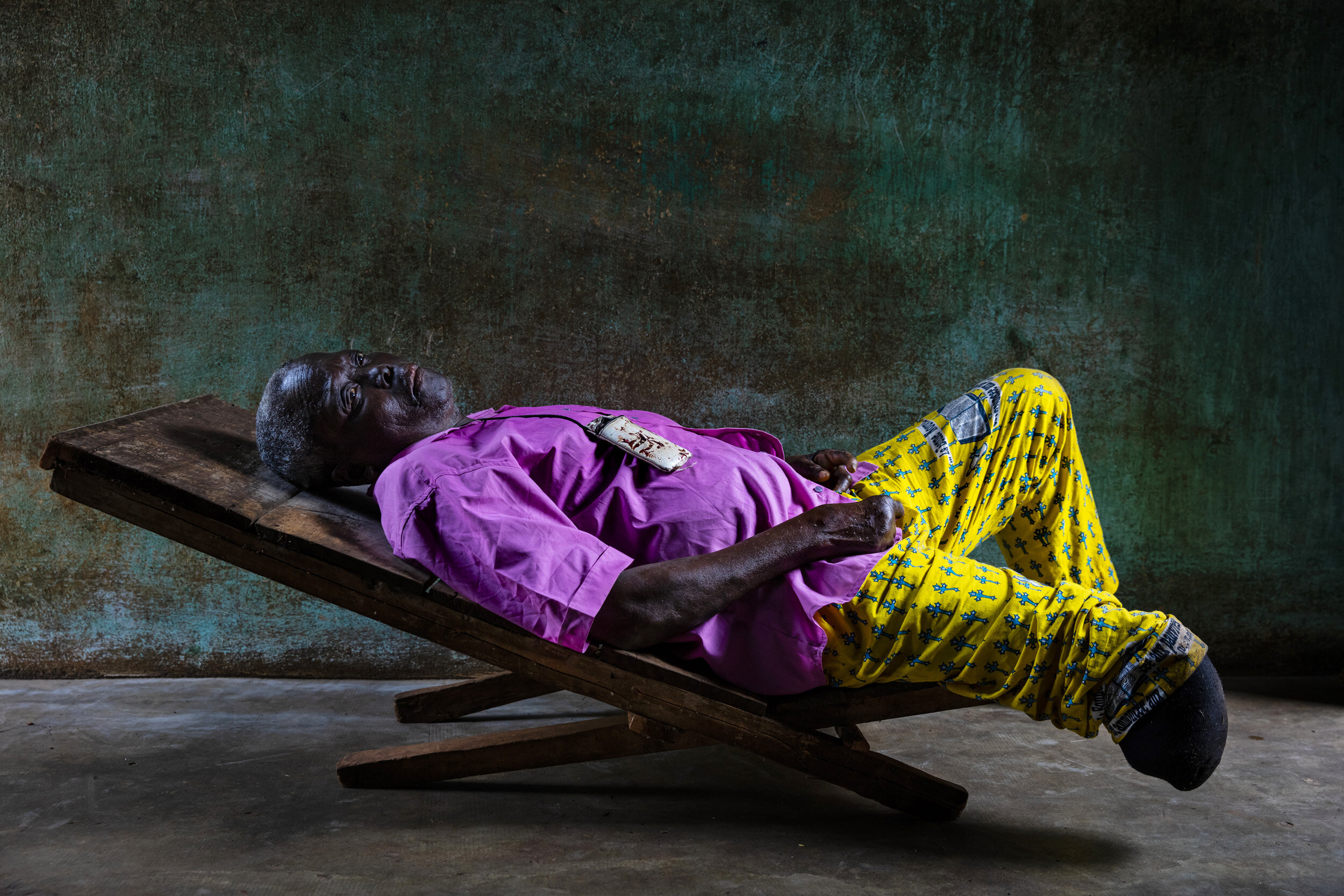
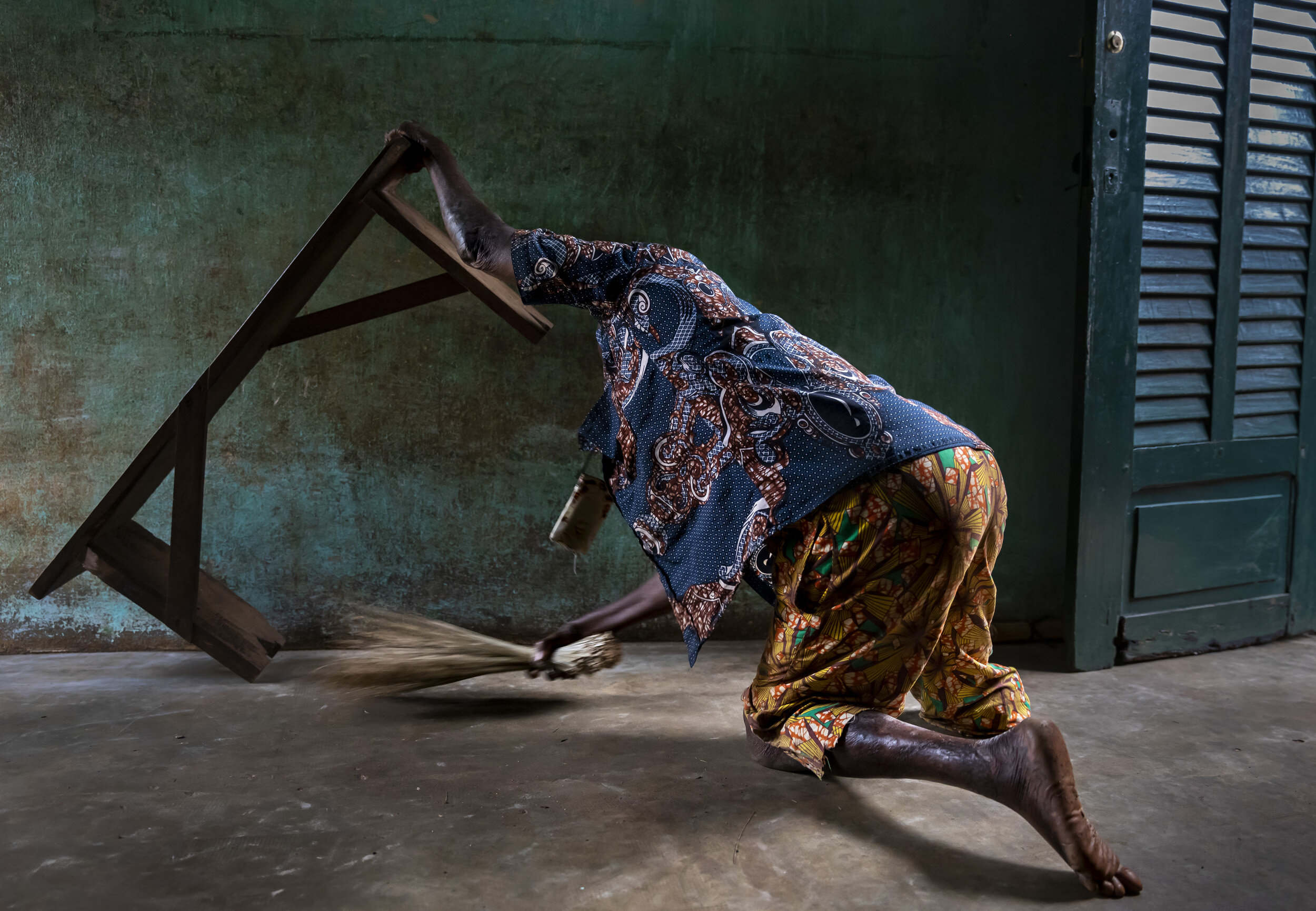
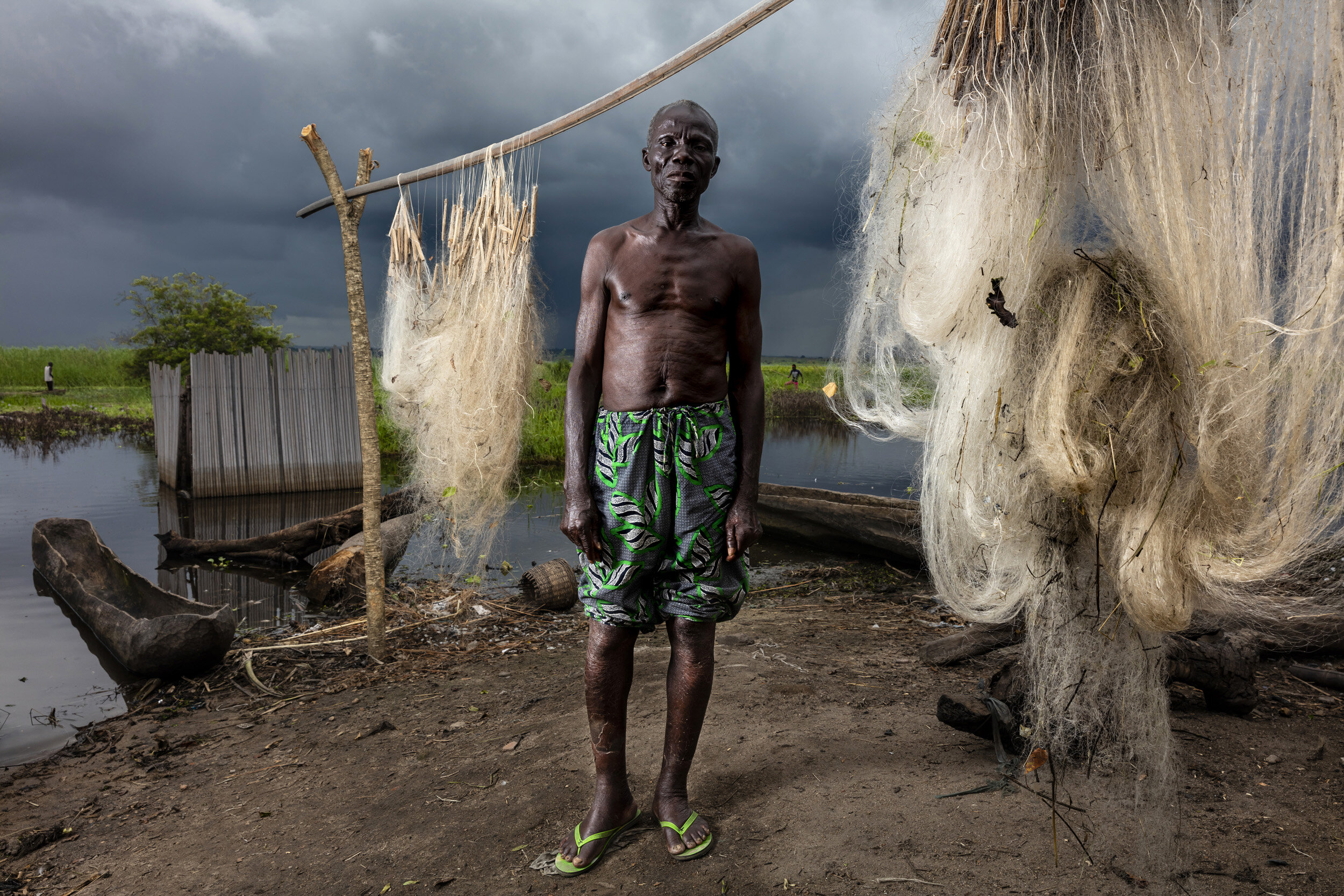
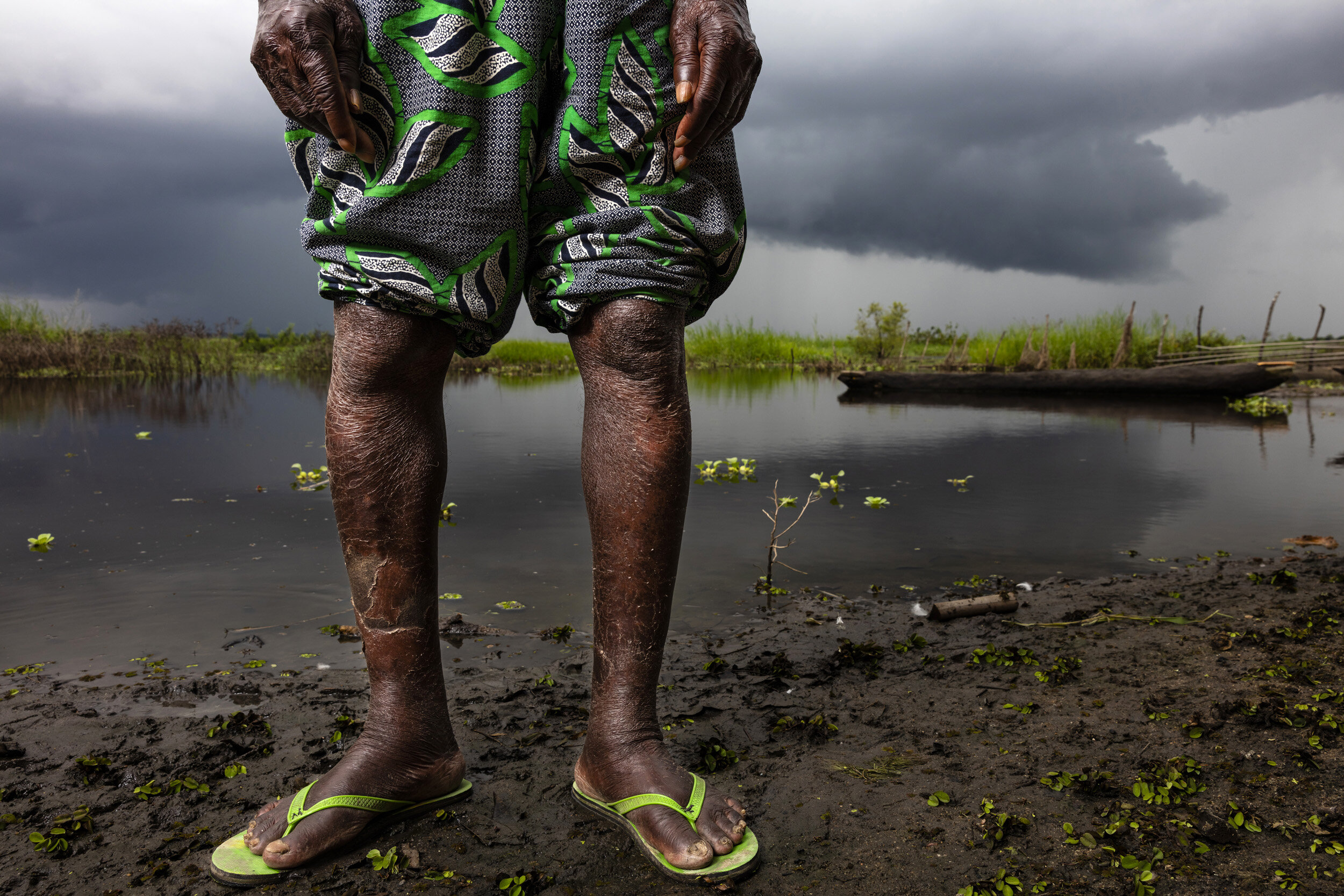
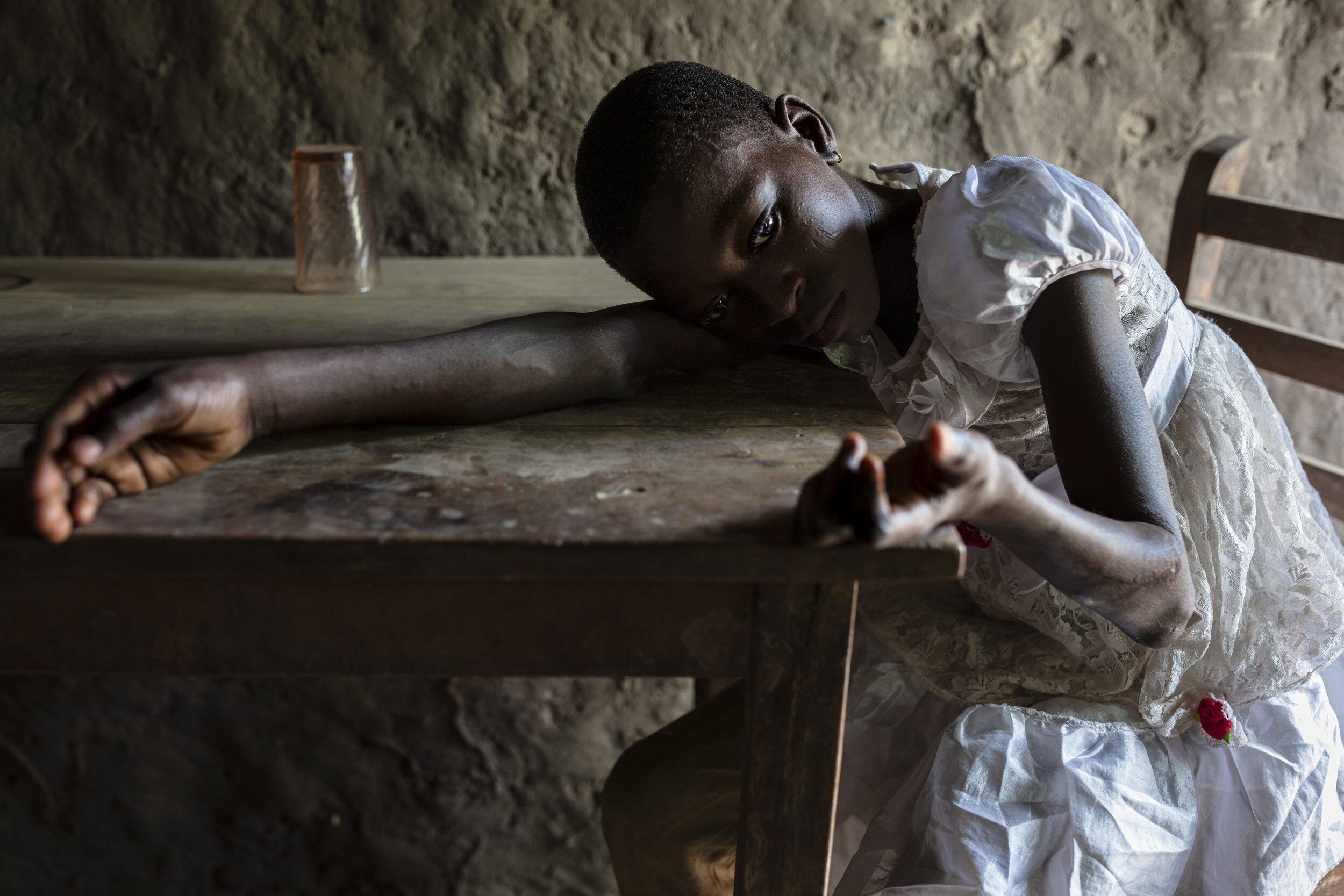

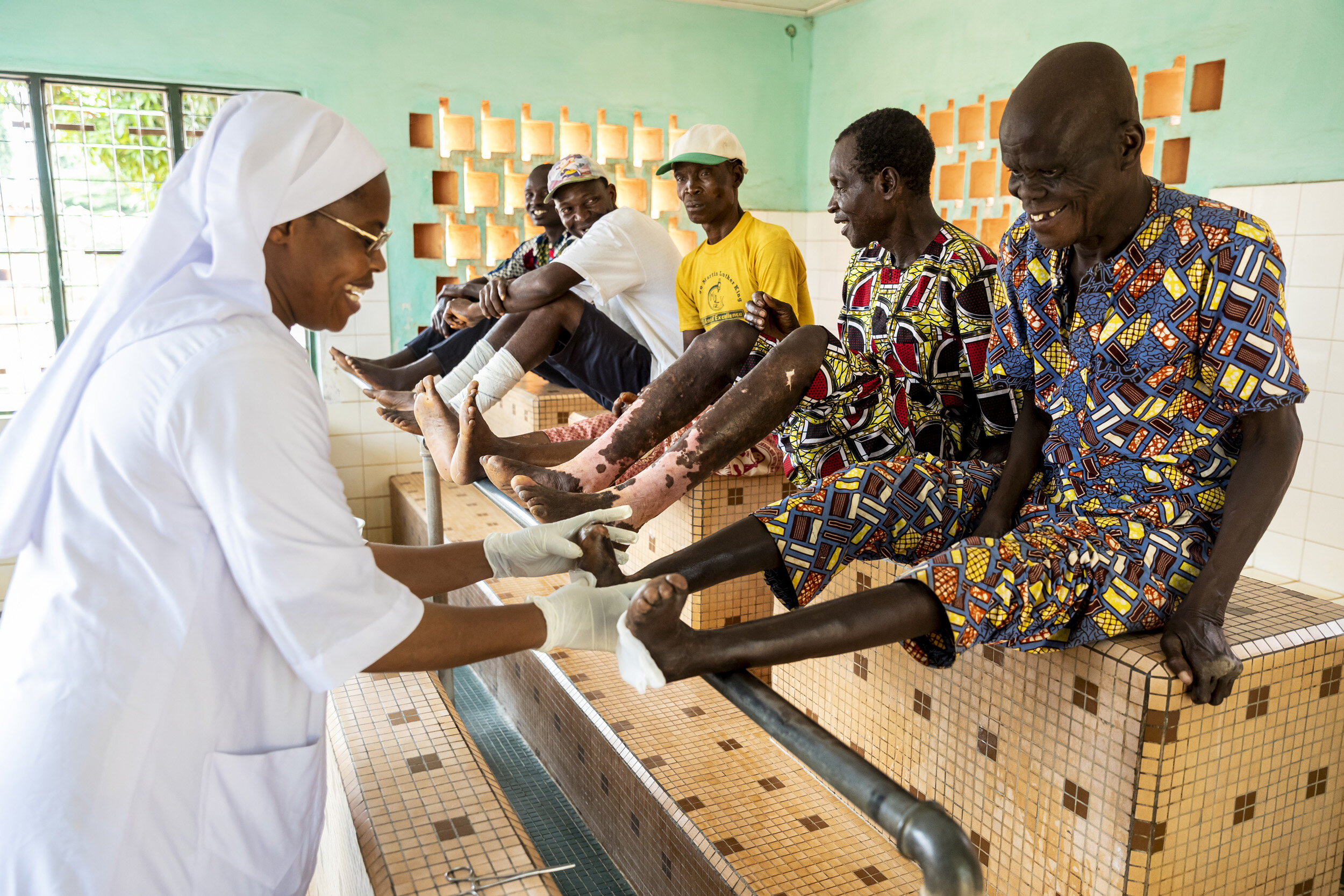
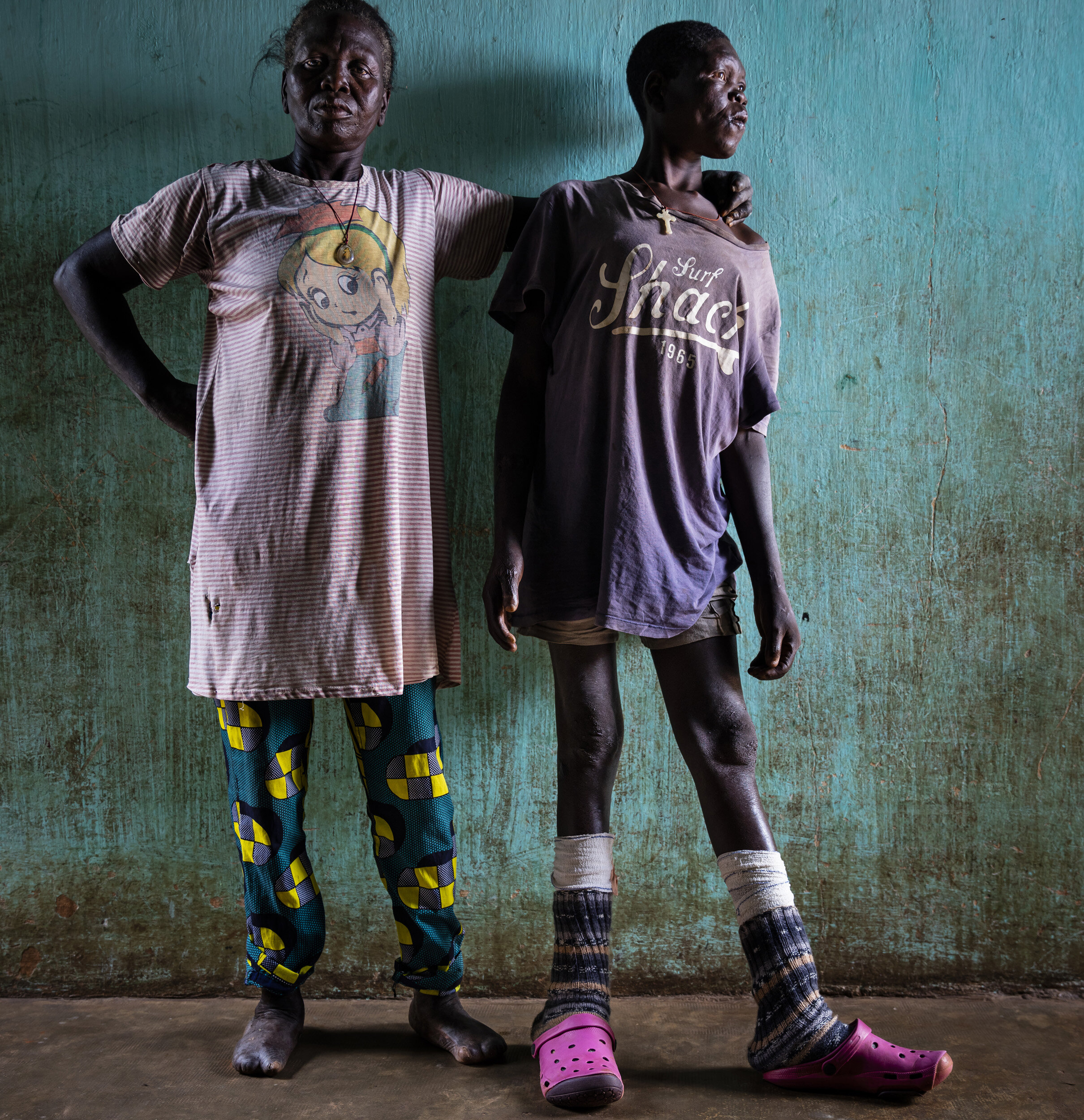
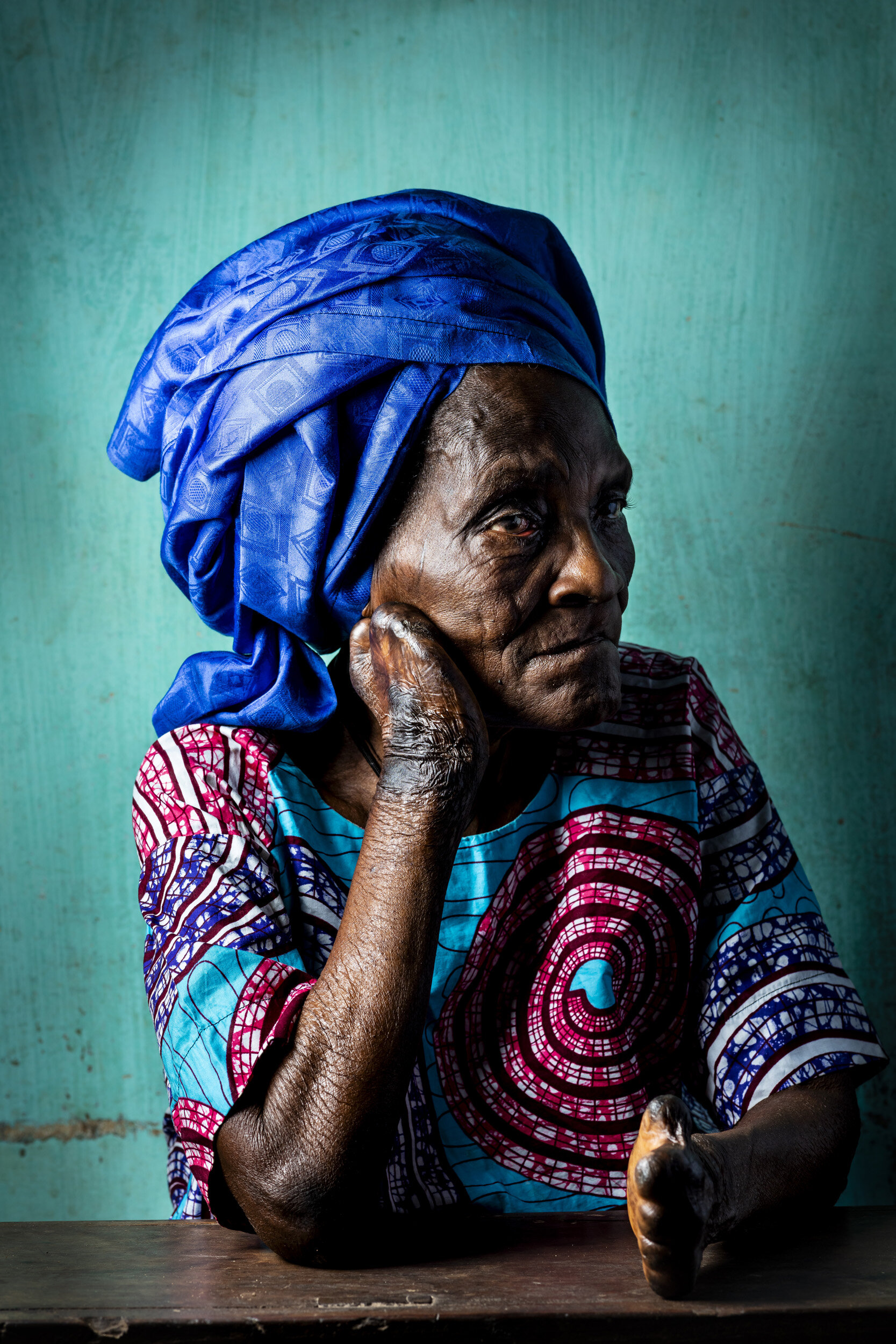


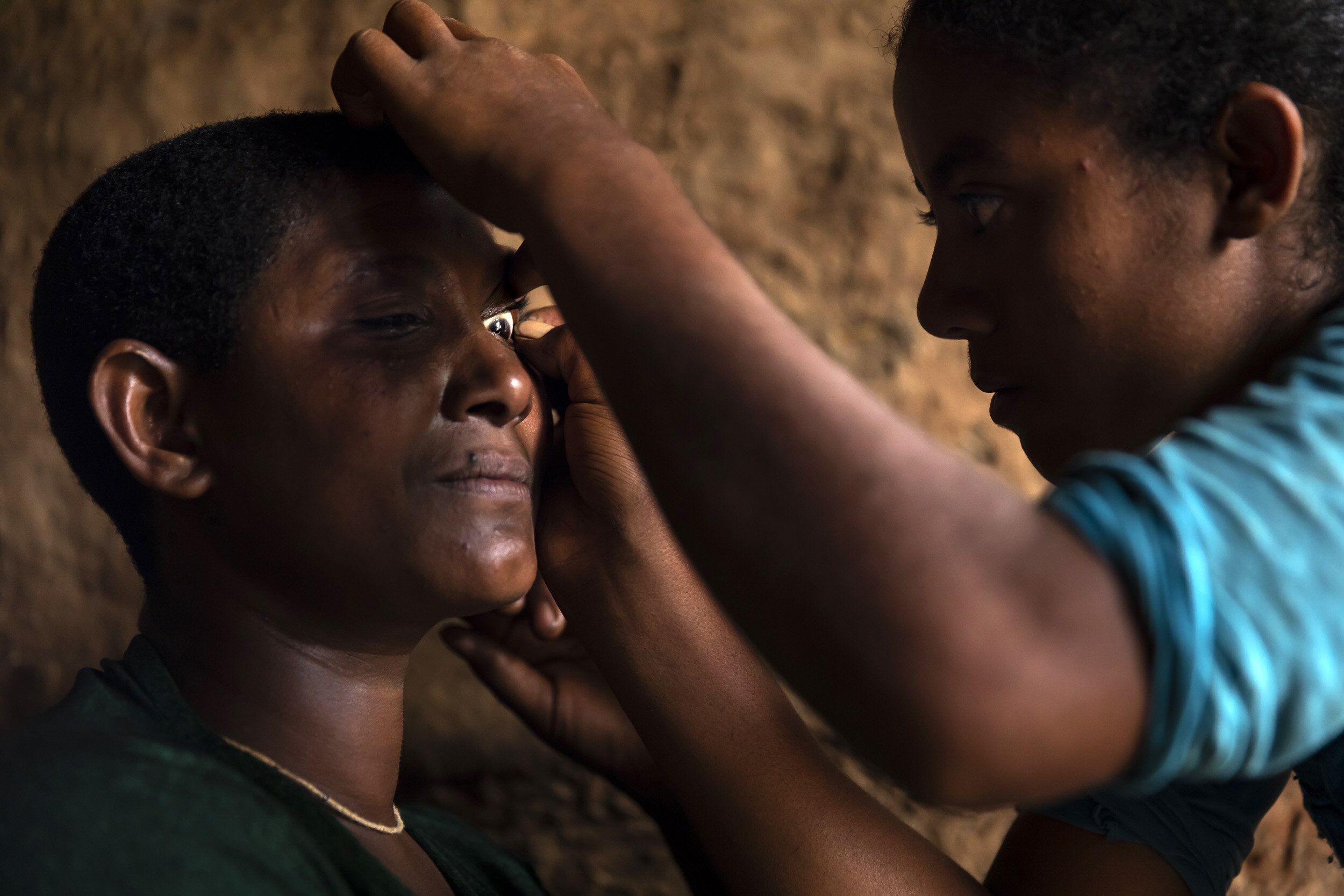

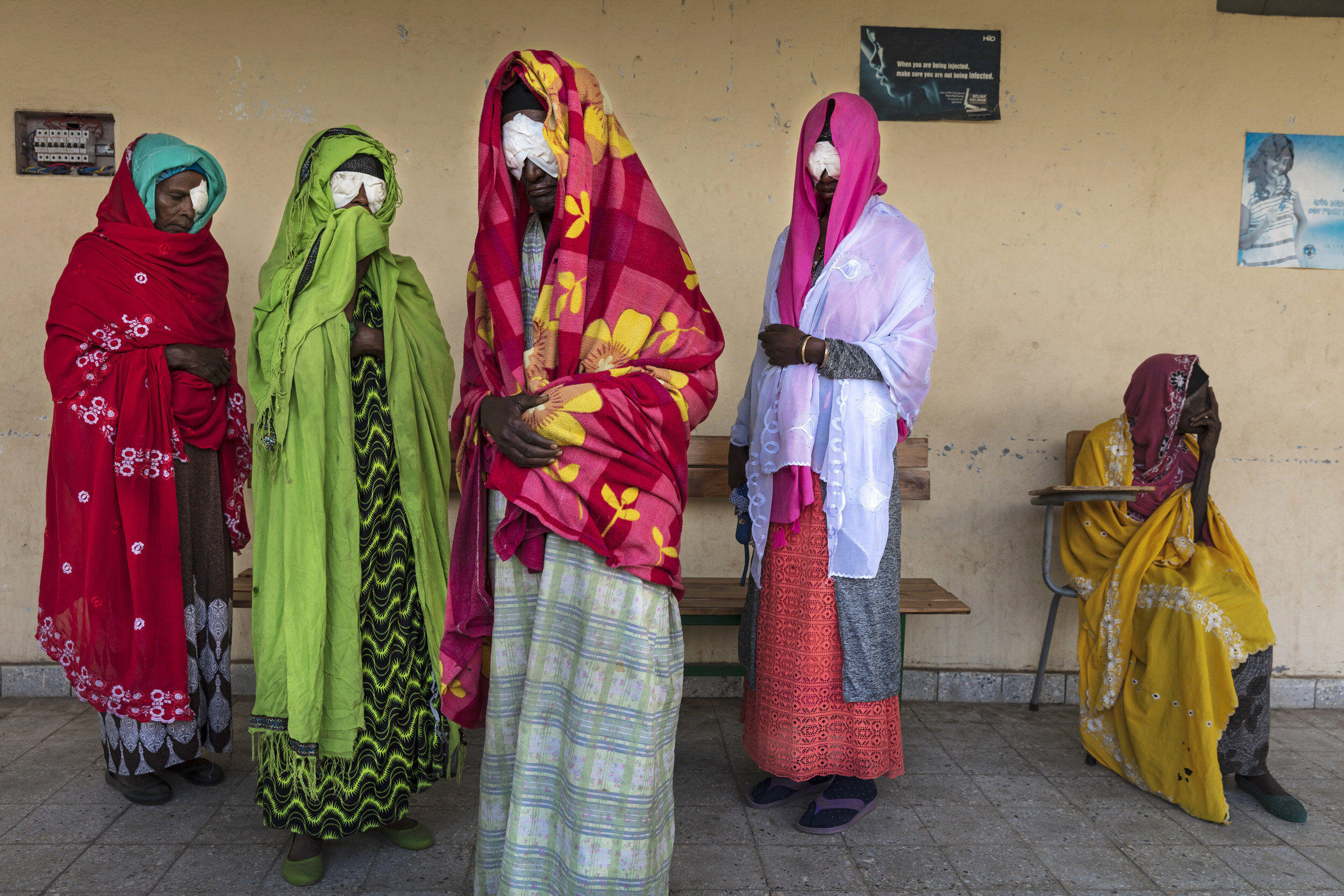
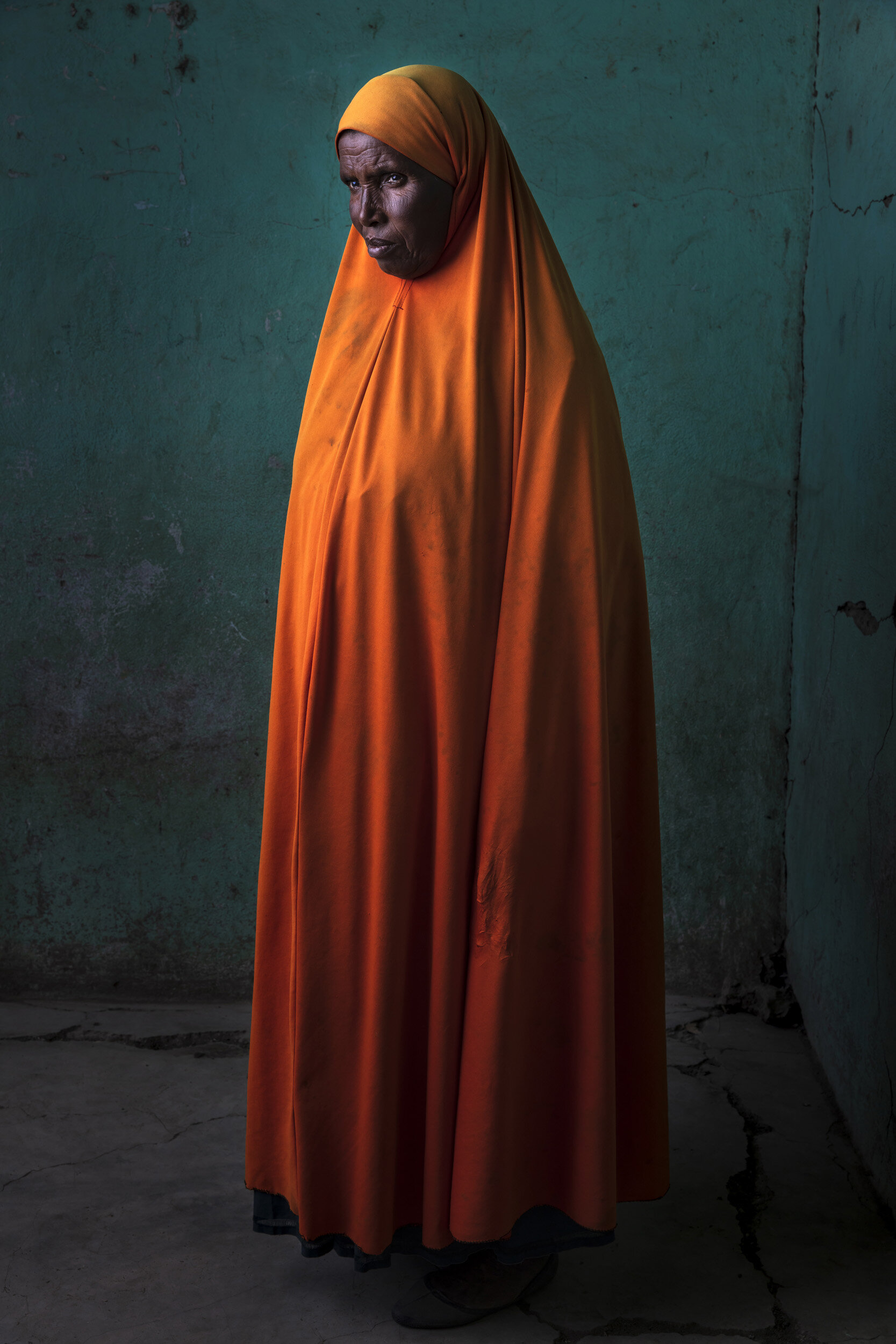
OUIDAH, BENIN, 25 OCTOBER 2019: Assiba Atonhou is only 24 years old. She has a four year-old son named Jeremy. Assiba contracted leprosy when she was 12 years old and it has ravaged her young body. She first discovered a wound on her arm that she said burnt her. Her parents took her to a traditional healer and he wasted their time and money for a few crucial years while the disease took over her body. Assiba says she was close to death when her parents were visited by one of a sisters of the local leprosy center. The sisters discovered her there and nursed her back to life. Assiba received treatment there for 3 years and then went home again. She became pregnant around that time. After she gave birth, she says the wounds reappeared and she became sick again. Assiba has lost faith in the treatment which she says does not work for her. Her biggest concern is Jeremy and how to pay for his schooling. Jeremy’s father is not involved at all and has abandoned his child. Assiba is totally reliant on the center for support and even though she says she is very bored of being there, she must remain as she has no other means of support. She prays often that she can be cured and leave the center for a normal life. (Photo by Brent Stirton/Getty Images)
OUIDAH, BENIN, 25 OCTOBER 2019: Assiba Atonhou is only 24 years old. She has a four year-old son named Jeremy. Assiba contracted leprosy when she was 12 years old and it has ravaged her young body. She first discovered a wound on her arm that she said burnt her. Her parents took her to a traditional healer and he wasted their time and money for a few crucial years while the disease took over her body. Assiba says she was close to death when her parents were visited by one of a sisters of the local leprosy center. The sisters discovered her there and nursed her back to life. Assiba received treatment there for 3 years and then went home again. She became pregnant around that time. After she gave birth, she says the wounds reappeared and she became sick again. Assiba has lost faith in the treatment which she says does not work for her. Her biggest concern is Jeremy and how to pay for his schooling. Jeremy’s father is not involved at all and has abandoned his child. Assiba is totally reliant on the center for support and even though she says she is very bored of being there, she must remain as she has no other means of support. She prays often that she can be cured and leave the center for a normal life. (Photo by Brent Stirton/Getty Images)
OUIDAH, BENIN, 25 OCTOBER 2019: Assiba Atonhou is only 24 years old. She has a four year-old son named Jeremy. Assiba contracted leprosy when she was 12 years old and it has ravaged her young body. She first discovered a wound on her arm that she said burnt her. Her parents took her to a traditional healer and he wasted their time and money for a few crucial years while the disease took over her body. Assiba says she was close to death when her parents were visited by one of a sisters of the local leprosy center. The sisters discovered her there and nursed her back to life. Assiba received treatment there for 3 years and then went home again. She became pregnant around that time. After she gave birth, she says the wounds reappeared and she became sick again. Assiba has lost faith in the treatment which she says does not work for her. Her biggest concern is Jeremy and how to pay for his schooling. Jeremy’s father is not involved at all and has abandoned his child. Assiba is totally reliant on the center for support and even though she says she is very bored of being there, she must remain as she has no other means of support. She prays often that she can be cured and leave the center for a normal life. (Photo by Brent Stirton/Getty Images)
MADJRE, DOGBO, BENIN: Patients at the Anti-Leprosy center in Madire, Benin. The patients at this center are here because they have been ostracized from their families and communities and have no-one to care fro them. There are currently 32 patients at the center and there are 9 centers across Benin. :eprosy remains a global disease, despite many people thinking it was eradicated centuries ago. Leprosy is a chronic bacterial disease that primarily affects the skin, peripheral nerves and upper airway. Feared as a highly contagious and devastating disease, it is well established that Hansen's disease (leprosy) is not highly transmissible, is very treatable, and, with early diagnosis and treatment, is not disabling. Leprosy remains a misunderstood human infectious disease. The stigma long associated with the disease still exists in most of the world and the psychological and social effects may be more difficult to deal with than the actual physical illness. (photo by Brent Stirton/Getty Images.)
MADJRE, DOGBO, BENIN, OCTOBER 22, 2019: Sister Alphonsine Hounkpe, 45, became a nun in 2003. She says it was always her calling, she remembers feeling this as young as 6 years old. She did not have access to education until later, starting school at 11. She then became a nurse before committing her life to the church in 2003. In 2015 she was asked to go to the Leprosy center in Madjre where she has been dispensing care ever since. Long term residents say she offers great care and love, more so than anyone else they can remember. They also say she has a great sense of humor and is funny and uplifting to be around. “This is my calling, she says, I am obliged to give them hope and joy.” (Photo by Brent Stirton/Getty Images.)
MADJRE, DOGBO, BENIN, OCTOBER 22, 2019: Gilbert Abalo, 55, is a child victim of Leprosy, he has suffered from the symptoms for over 40 years. He has lived at the Madjre Anti-Leprosy center for over 25 years. He lost his leg to gangrene over 6 years ago. Throughout it all, Gilbert has maintained an incredible sense of humor, “I laugh all the time, this disease is not a curse from someone else, like some people think. It is just something I live with now. It is in the hands of God.” Gilbert was unable to marry despite a woman he knew wanting that. Her parent prevented the union. Now he lives quietly at the center, raising chickens, maintaining a perfectly clean house and bringing humor wherever he goes. (Photo by Brent Stirton/Getty Images.)
MADJRE, DOGBO, BENIN, OCTOBER 22, 2019: Gilbert Abalo, 55, is a child victim of Leprosy, he has suffered from the symptoms for over 40 years. He has lived at the Madjre Anti-Leprosy center for over 25 years. He lost his leg to gangrene over 6 years ago. Throughout it all, Gilbert has maintained an incredible sense of humor, “I laugh all the time, this disease is not a curse from someone else, like some people think. It is just something I live with now. It is in the hands of God.” Gilbert was unable to marry despite a woman he knew wanting that. Her parent prevented the union. Now he lives quietly at the center, raising chickens, maintaining a perfectly clean house and bringing humor wherever he goes. (Photo by Brent Stirton/Getty Images.)
Agnove Island, Benin: This island is a place where Lepers were once isolated, living lives cut off from society. Today, it is a fishing village and there are only three people on the island with Leprosy. This is because the local hospital is aware of the disease and medical personel who work in this area know what to look for. Dadjro Adoubekenon, 74, is from a family where three people had leprosy. He has it now but is on treatment and remains hopeful about returning to work as a fisherman once his treatment is complete. He has 6 kids and his primary concern is how to support his family. Prior to going on treatment for the disease, Dadjro did not leave his house for 4 months and his family were preparing for his death. Leprosy is a chronic bacterial disease that primarily affects the skin, peripheral nerves and upper airway. Feared as a highly contagious and devastating disease, it is well established that Hansen's disease (leprosy) is not highly transmissible, is very treatable, and, with early diagnosis and treatment, is not disabling. Leprosy remains a misunderstood human infectious disease. The stigma long associated with the disease still exists in most of the world and the psychological and social effects may be more difficult to deal with than the actual physical illness. (photo by Brent Stirton/Getty Images.)
Agnove Island, Benin: This island is a place where Lepers were once isolated, living lives cut off from society. Today, it is a fishing village and there are only three people on the island with Leprosy. This is because the local hospital is aware of the disease and medical personel who work in this area know what to look for. Dadjro Adoubekenon, 74, is from a family where three people had leprosy. He has it now but is on treatment and remains hopeful about returning to work as a fisherman once his treatment is complete. He has 6 kids and his primary concern is how to support his family. Prior to going on treatment for the disease, Dadjro did not leave his house for 4 months and his family were preparing for his death. Leprosy is a chronic bacterial disease that primarily affects the skin, peripheral nerves and upper airway. Feared as a highly contagious and devastating disease, it is well established that Hansen's disease (leprosy) is not highly transmissible, is very treatable, and, with early diagnosis and treatment, is not disabling. Leprosy remains a misunderstood human infectious disease. The stigma long associated with the disease still exists in most of the world and the psychological and social effects may be more difficult to deal with than the actual physical illness. (photo by Brent Stirton/Getty Images.)
Dogbo, Benin: Ouinsson Hounssi, 12, is a recent survivor of Leprosy. She contracted the disease from her mother, who did not know she had the disease.. They were both treated at the same time, on an anti-biotic regime for a year. The bacteria that causes the disease is insidious and first attacks the nerve endings. typically in the feet and the hands. People who contract the disease usually find out too late to prevent nerve damage that is permanent. That is what happened to Ouinsson’s hands, they are permanently damaged from the disease, despite it being eradicated from her body. One of the key goals with those who fight against the spread of Leprosy is to get to children as early as possible to end deformity. There are currently 9 Leprosy centers in Benin and the disease is still present in many countries around the world. Leprosy is a chronic bacterial disease that primarily affects the skin, peripheral nerves and upper airway. Feared as a highly contagious and devastating disease, it is well established that Hansen's disease (leprosy) is not highly transmissible, is very treatable, and, with early diagnosis and treatment, is not disabling. Leprosy remains a misunderstood human infectious disease. The stigma long associated with the disease still exists in most of the world and the psychological and social effects may be more difficult to deal with than the actual physical illness. (photo by Brent Stirton/Getty Images.)
MADJRE, DOGBO, BENIN, OCTOBER 22, 2019: Beatrice Hounkpevi, 49, was 16 when she was first diagnosed with Leprosy. She lost her toes within the first two years. In 2018 she finally lost her leg to gangrene. She is seen having a talk and a laugh with Sister Alphonsine who takes care of the lepers with two other sisters. They have an excellent relationship and Beatrice says Sister Alphonsine helps her in life every day. Beatrice was born in Togo and explains that when she went to school there, they had to cross a river twice a day to get there. She believes that is where she contracted Leprosy. Beatrice has had two husbands, both of whom left her because of the disease. She had 5 children with her second husband, when he left her he decided to ban her children from seeing her, the great tragedy in her life. “From time to time, I will receive a phone call from one of them, that is the thing I live for. A call is enough and so I pray for that call.” (Photo by Brent Stirton/Getty Images.)
MADJRE, DOGBO, BENIN, OCTOBER 22, 2019: Sister Alphonsine Hounkpe, 45, is seen cleaning the wounds of lepers at the anti-leprosy center in Madjre. She became a nun in 2003. She says it was always her calling, she remembers feeling this as young as 6 years old. She did not have access to education until later, starting school at 11. She then became a nurse before committing her life to the church in 2003. In 2015 she was asked to go to the Anti Leprosy center in Madjre where she has been dispensing care ever since. Long term residents say she offers great care and love, more so than anyone else they can remember. They also say she has a great sense of humor and is funny and uplifting to be around. “This is my calling, she says, I am obliged to give them hope and joy.” (Photo by Brent Stirton/Getty Images.)
MADJRE, DOGBO, BENIN, OCTOBER 22, 2019: Mother and Son, Angele Assi, 54 and her son Cyprien Tohou Egnon, 25. They have lived at the Madjre Anti-Leprosy center since 2017. In addition to Leprosy, Cyprien has some mental issues linked to the disease. Angele say of Cypriene, “He is my son, I will always be with him.” When Angele first displayed symptons, she went to a series of traditional healers who wasted valuable time and money in their misdiagnosis. This has been a common theme for many of these victims. Leprosy can be treated but it is vital it is diagnosed early and anti-biotics administered. Poverty, remote location, superstition, ignorance and a lack of qualified medical personnel all contribute to the endurance of this disease. (Photo by Brent Stirton/Getty Images.)
MADJRE, DOGBO, BENIN, OCTOBER 22, 2019: Veronica Gbado, 85, has had leprosy since the ago of 20. As a young woman, she lived in an area without access to western medicine and traditional healers wasted her time and money, resulting in a permanent condition. Veronica has lived in the Madjre Anti-Leprosy center for 21 years. She had five children in her life, 4 of whom died. She blames the tragedies of her life on witchcraft. (Photo by Brent Stirton/Getty Images.)
Ouidah, Benin: Robert Hounkankin, 8, developed a Burilli ulcer two months ago and it has already done serious damage to his arm. Buruli ulcer, caused by Mycobacterium ulcerans, is a chronic, debilitating, necrotizing disease of the skin and soft tissue. Buruli ulcer is an emerging infectious disease and is the third most common mycobacterial disease of the immunocompetent host, after tuberculosis and leprosy. Although it has been reported in over 33 countries around the world, the greatest burden of disease is in the tropical regions of West and Central Africa, Australia, and Japan. It primarily affects children aged 5-15 years. Buruli ulcers generally begin as a painless dermal papule or subcutaneous edematous nodule, which, over a period of weeks to months, breaks down to form an extensive necrotic ulcer with undermined edges. Treatment includes a prolonged course of antibiotics and surgical debridement. Early identification and treatment are key, as lesions heal with scarring that can be a significant source of morbidity. (Photo by Brent Stirton/Getty Images.)
Ouidah, Benin: Joie Nontcho, 9, has been in hospital for the last two years due to debilitating and chronic Buruli ulcers which have been very difficult to get rid of. His sister dropped out of school and is with him to ensure he is cared for. Buruli ulcer, caused by Mycobacterium ulcerans, is a chronic, debilitating, necrotizing disease of the skin and soft tissue. Buruli ulcer is an emerging infectious disease and is the third most common mycobacterial disease of the immunocompetent host, after tuberculosis and leprosy. Although it has been reported in over 33 countries around the world, the greatest burden of disease is in the tropical regions of West and Central Africa, Australia, and Japan. It primarily affects children aged 5-15 years. Buruli ulcers generally begin as a painless dermal papule or subcutaneous edematous nodule, which, over a period of weeks to months, breaks down to form an extensive necrotic ulcer with undermined edges. Treatment includes a prolonged course of antibiotics and surgical debridement. Early identification and treatment are key, as lesions heal with scarring that can be a significant source of morbidity. (Photo by Brent Stirton/Getty Images.)
Gedefaye Metikie has had minor trichiasis (TT) for 3 or 4 years but has put off her surgery until her youngestchild is weaned. In the meantime, her oldest daughter Yalemworke Gashaw lovingly epilates the eyelashesrubbing against her mother’s eye between her fingernails in North Mecha Woreda, Amhara Region, Ethiopia.Gedefaye is aware that a simple 10–15 minute surgery is available free of charge through the Lions/CarterCenter Sightfirst Initiative offered by the Amhara Regional Health Bureau. Trachoma is an eye infection caused by the bacterium Chlamydia trachomatis. The bacterium is spreadby direct person-to-person contact, shared cloths and towels, and by eye-seeking flies. Children ages1–9 years and women harbor the greatest burden of disease. Repeated infections scar the inner eyelid,eventually causing the eyelid to turn inward. Once the eyelid has inverted, the eyelashes scratch thecornea, leading to irreversible blindness. Photo Credit: Brent Stirton/GettyImages
Esmael Habtamu from The Carter Center for Trachoma Control Program is seen checking an elderly lady for signs oftrachoma in North Mecha Woreda, Amhara region of Ethiopia. The Amhara region is the most endemic area inthe most endemic country. Trachoma is an eye infection caused by the bacterium Chlamydia trachomatis. The bacterium is spreadby direct person-to-person contact, shared cloths and towels, and by eye-seeking flies. Children ages1–9 years and women harbor the greatest burden of disease. Repeated infections scar the inner eyelid,eventually causing the eyelid to turn inward. Once the eyelid has inverted, the eyelashes scratch the cornea, leading to irreversible blindness. (Photo credit: Brent Stirton/Getty Images)
North Mecha Woreda, Amhara region of Ethiopia. A group of five woman all from the same family, all suffering from Trachoma induced blindness. They are waiting to have their eye covering removed after a remote clinic from the Carter foundation reached their area and identified them as candidates for surgery. The Amhara region is the most endemic area in the most endemic country. for Trachoma. Trachoma is an eye infection caused by the bacterium Chlamydia trachomatis. The bacterium is spreadby direct person-to-person contact, shared cloths and towels, and by eye-seeking flies. Children ages1–9 years and women harbor the greatest burden of disease. Repeated infections scar the inner eyelid,eventually causing the eyelid to turn inward. Once the eyelid has inverted, the eyelashes scratch the cornea, leading to irreversible blindness. Photo by Brent Stirton/Getty Images
North Mecha Woreda, Amhara region of Ethiopia. A local woman suffering from Trachoma induced blindness. She is waiting to see if her her eyes can be operated on by a remote clinic from the Carter foundation that reached their area and identified them as potential candidates for surgery. The Amhara region is the most endemic area in the most endemic country. for Trachoma. Trachoma is an eye infection caused by the bacterium Chlamydia trachomatis. The bacterium is spreadby direct person-to-person contact, shared cloths and towels, and by eye-seeking flies. Children ages1–9 years and women harbor the greatest burden of disease. Repeated infections scar the inner eyelid, eventually causing the eyelid to turn inward. Once the eyelid has inverted, the eyelashes scratch the cornea, leading to irreversible blindness. Photo by Brent Stirton/Getty Images
